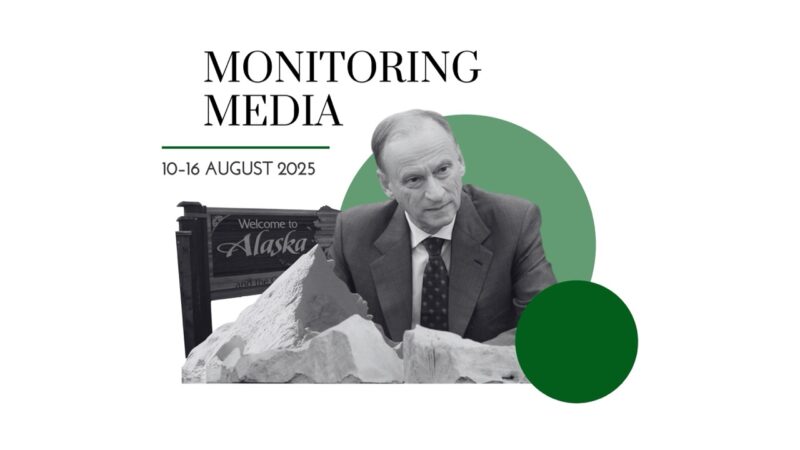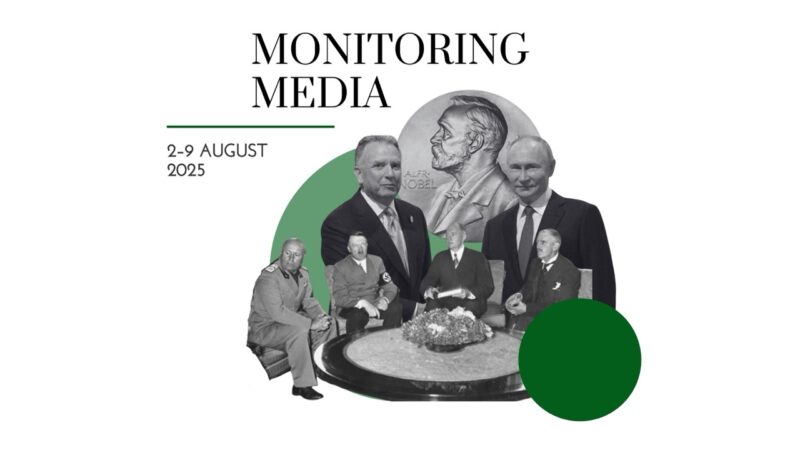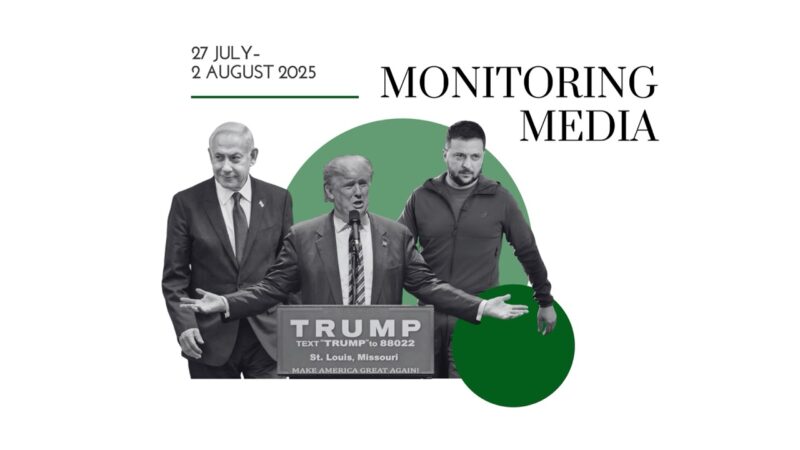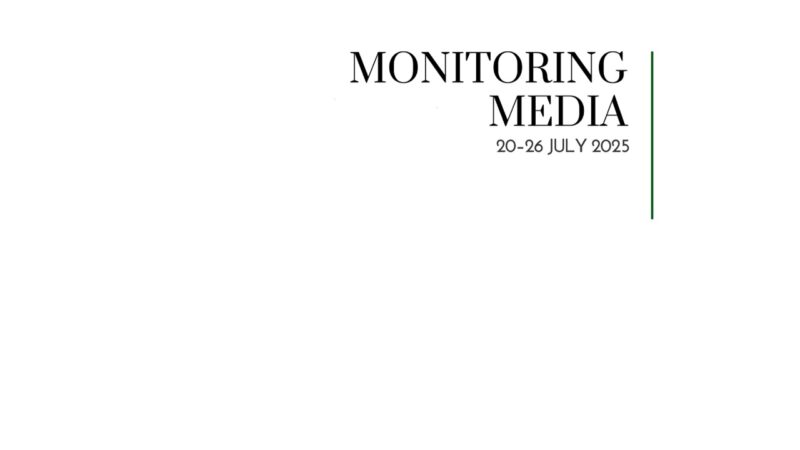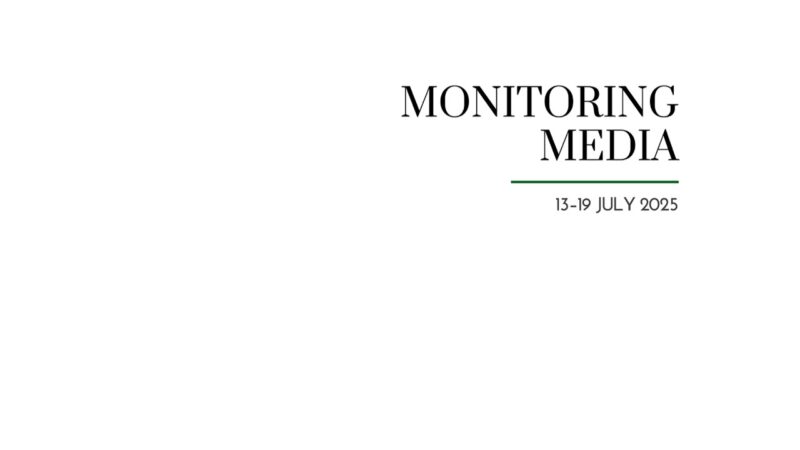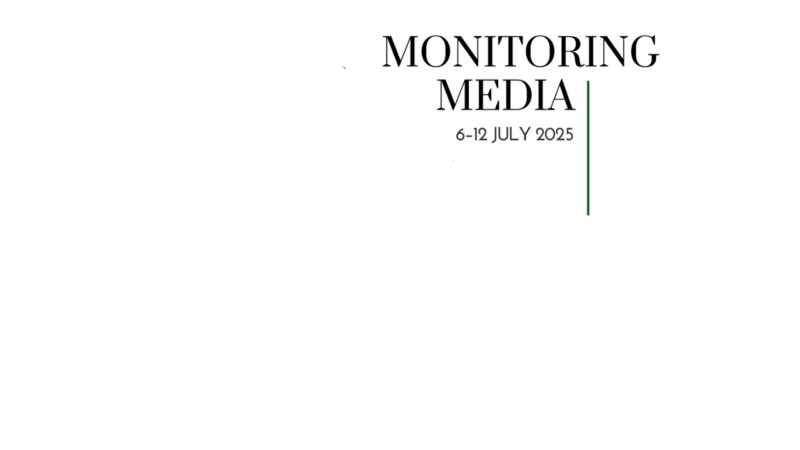Russia is not winning, resorting to mules on the battlefield

CIUS weekly report on North American media coverage of Ukrainian affairs, 2–8 March 2025
Five publications (Foreign Affairs, Foreign Policy, The Atlantic, The New York Times, and The Globe and Mail) were selected to prepare this report on how Ukraine has been portrayed in the North American press during the past week. The sample was compiled based on their impact on public opinion as well as on their professional reputation, popularity among the readership, and topical relevance. These publications represent centrist viewpoints on the political spectrum.
This MMS report covers only the most-read and relevant articles about Ukraine, as ranked by the respective North American publications themselves in the past week. Its scope covers promoted articles on home pages and articles from special sections on Ukraine, with the hashtag #Ukraine, from the paper editions of the publications, and about Ukraine from opinion columns and editorials.
Featured topics
- The world and Ukraine: Ukraine’s minerals will not solve US supply chain problems; it is Europe’s war now; peace in Ukraine must be achieved through strength; Trump’s shift toward Russia leaves Ukraine, Europe vulnerable.
- Russia at war: Russia is not winning, resorting to mules on the battlefield.
MMS summaries
Ukraine’s minerals will not solve US supply chain problems. Joshua Busby, Emily J. Holland, and Morgan D. Bazilian (Foreign Policy) believe that a possible deal between Kyiv and Washington on rare earths mining in Ukraine may not give the US what it wants: “The unique realities of global minerals markets—as well as logistical conditions on the ground in Ukraine—make it highly unlikely that these assets would have any meaningful impact on U.S. national and economic security in the short and medium term.” Among the factors offsetting the value of Ukrainian rare earths to the US are, first, that the extent of resources and known reserves in Ukraine is unclear, due to limited data: “The last known assessment of the country’s mineral resources was done during Soviet geological surveys conducted between 1960 and 1980 using outdated exploration methods.” Second, there is confusion about definitions: “It is possible that the media and Trump himself may have conflated rare-earth metals with the broader group of critical minerals. Ukraine does have some commercially viable deposits of titanium and gallium, which are both strategically important minerals with civilian and military applications.” However, reliable information on known and economically viable deposits of rare earth metals in Ukraine is either absent or classified. Third, even if new geological surveys confirm the presence of significant reserves of rare earth and critical mineral resources in Ukraine, “the commercial viability of extracting these resources may be low.” Fourth, availability of mineral resources is secondary to the availability of processing capacities: “Even if the United States could access minerals through ally-shoring or the types of arrangements that are being proposed in Ukraine, China holds a majority the world’s refining and production capacity. For example, US government researchers found that although China mined less than 20 percent of the world’s total supply of lithium in 2019, it controlled more than 60 percent of its production capacity.” Fifth, Washington’s pressure on Kyiv to reach a deal could backfire: “If Washington were to conclude a deal with Ukraine that is widely perceived as exploitative, then it may undercut the claim that the United States is a more benign and better partner than China.” According to the authors, “An inequitable deal with Ukraine could not only damage US legitimacy in Ukraine but also make it harder to conclude agreements elsewhere with countries that have active mining sectors.”
It is Europe’s war now. Dmytro Kuleba (New York Times) argues that Russia’s war against Ukraine has become a European responsibility. Washington wants to achieve peace in the Russo-Ukrainian war but does not understand the context: “On the same day that Mr. Trump spoke of the importance of peace and sent Mr. Zelensky home to think about it, Russia launched more than 150 attack drones on Ukrainian cities. While Mr. Trump emphasizes that he is making great progress with President Vladimir Putin of Russia toward peace, the latter has only increased his strikes since the inauguration.” In contrast, Europe has a better perception of the context and conditions required for peace: “Europeans understand, as the Trump administration appears not to, that Ukraine wants a peace deal—it just doesn’t want to end up destroyed by the peace terms.” Russia’s invasion is the result of the Kremlin’s obsession with Ukraine, not the threat of its accession to NATO: “The obsession of Mr. Putin is all of Ukraine, nothing less. It is neither NATO nor a strip of Ukrainian land. If Ukraine is still independent and armed by the end of negotiations, Mr. Putin will not see that as the end. He will settle for a piece of Ukraine today only to come for the whole tomorrow.” A successful democratic Ukraine threatens the Moscow regime and is the main barrier to making Russia great again. Europe has taken steps to strengthen its role in resolving the war, but it needs to take two more steps to seize the initiative: “Offer an alternative agreement on Ukraine’s minerals, and confiscate Russian frozen assets to use them to finance the production and purchase of arms—including from the United States, if they wish.” According to Kuleba, “Moscow never really changes, but Europe still might.”
Russia is not winning, resorting to mules on the battlefield. Graeme Wood (Atlantic) criticizes the idea that Moscow will win the war. In 2024 Russia did indeed dominate the battlefield, but the price of its dominance was extremely high: “Tens of thousands, possibly hundreds of thousands of Russian soldiers were killed or wounded, and whole mechanized divisions were lost, in exchange for Ukrainian territory slightly larger than the state of Rhode Island.” According to the authors, “At the current rate, Russia will control all of Ukraine in about 118 years.” Ukraine’s position is difficult, but Russia’s is no easier and perhaps even more difficult, as “Russians taste the extra bitterness that comes with the knowledge that they could, in February 2022, have just stayed home and not started the war.” Russia is so exhausted that it is resorting to using mules instead of mechanized machinery: “The United States military has protocols for the modern use of mules in jungles and in rugged, craggy terrain. To use them in the flatlands of eastern Ukraine suggests desperation.” If Ukraine continues to receive military aid at the level it was receiving before President Trump’s decision, it will completely exhaust Russia in the short term. According to Wood, Ukraine is assessing that “at the current rate, Russia will eventually run out of men, tanks, money, and the will to fight. If Ukraine is in that position—having to hold out, and suffer and inflict more death and destruction for another year or more—then its position is unenviable, but it is not a losing one.”
Peace in Ukraine must be achieved through strength. Paul Avey (Foreign Affairs) argues that Europe should play a more active role in resolving the Russo-Ukrainian war, but the US should not remain aloof. US-Ukrainian relations becoming tense from time to time should not be an obstacle, and Washington should not pander to Moscow’s vision of the war ending: “The outcome that Putin wants would be a Ukraine that is permanently stripped of almost 25 percent of its territory, demilitarized, and barred from joining the EU and NATO. Agreeing to those terms would mean capitulating to Russian aggression and virtually guaranteeing Ukraine’s future absorption into Russia.” This approach will not bring sustainable and just peace. The best way to end the war will instead follow a “peace through strength” approach: “Such an approach would substantially enhance Europe’s role in supporting Ukraine militarily and economically, with a limited but important backup role for the United States; accept the current lines of control between Russian and Ukrainian forces, without recognizing Russian annexation or sovereignty over Russian-occupied areas; and prepare the path for a negotiated settlement—all while considering, in the likely event that negotiations fail, how to achieve a cease-fire through unilateral action.” In the author’s opinion, to pave this way Ukraine, Europe, and the United States should focus on four priorities: “Strengthening Ukraine militarily, applying additional economic pressure on Russia (but relaxing sanctions if it complies with an agreement), addressing Ukrainian security and economic needs through EU membership, and deterring Russia by granting Ukraine NATO membership.” If the peace talks fail, these four priorities will remain the best basis for a Ukrainian, European, and American strategy going forward. According to Avey, “A peace that ensures a sovereign and secure Ukraine would send a clear message that Trump will stand strong against any use of force by these countries against US allies and friends. It will significantly enhance Trump’s credibility and the prospect for peace not only in Europe but also in the Indo-Pacific and in the Middle East.”
Trump’s shift toward Russia leaves Ukraine, Europe vulnerable. Michael Bociurkiw (Globe and Mail) highlights that Ukraine faces an increasingly dire battlefield reality as the United States retreats from its traditional role of Europe’s security guarantor. President Volodymyr Zelensky’s recent European tour highlighted this shifting landscape: while he received a warm welcome from allies, their pledges fell short of what Ukraine needs to counter Russia’s relentless aggression. UK Prime Minister Keir Starmer offered a £2.26-billion defence loan and air defence missiles, but European Commission President Ursula von der Leyen’s vision of making Ukraine a “steel porcupine, indigestible to invaders” will remain only aspirational without decisive military backing. Meanwhile, French President Emmanuel Macron’s proposal for a one-month truce appears detached from reality as Russian forces intensify their strikes on Ukrainian cities and infrastructure. This hesitation among allies is allowing Russia to advance unchecked, and Bociurkiw warns that unless there is firm US deterrence, “the consequences for Ukraine could be catastrophic.” If Russia seizes southern cities Mykolaiv and Odesa, it would not only landlock Ukraine but also destabilize European security on a broader scale. Washington’s accelerating rapprochement with Moscow signals even greater risks ahead. The Kremlin has reaped major diplomatic and strategic concessions without offering anything in return, from the US suspending offensive cyber operations against Russia to President Putin’s spokesman openly stating that US foreign policy now “largely coincides with our vision.” The recent attack on an Odesa port, which struck a Swiss-owned container ship, underscores how vulnerable Ukraine remains, with foreign investors and insurers wary of Russian aggression, the author notes. Yet, rather than reinforcing Ukraine’s defences, many in Trump’s circle have mocked Zelensky and even called for his resignation—parrotting Kremlin propaganda messages. Bociurkiw believes that the US could go as far as disabling the Patriot missile systems it has provided or even acting on Elon Musk’s past threats to restrict Starlink access. The author offers a grim prediction that Europe—and especially Ukraine—may soon have to face “the Russian bear alone.”
Despite the Oval Office standoff, Ukraine is stronger now than at war’s outset in 2022. Mark MacKinnon (Globe and Mail) argues that US President Donald Trump’s latest confrontation with Volodymyr Zelensky underscores a stark reality: while Washington may be stepping away from Ukraine, Ukrainians remain steadfast in their fight for survival. The Oval Office exchange, in which Trump pushed for a ceasefire and berated Zelensky for resisting, highlighted a fundamental disconnect. Trump’s insistence on an immediate ceasefire—without addressing Russia’s aggression—mirrors past Western missteps such as the Minsk agreements, which failed to deter further Russian expansion. “Ask our people about a ceasefire, what they think,” Zelensky fired back, making it clear that Ukrainians, shaped by their history of betrayal and war, will not accept another deal that merely freezes the war while leaving the threat intact. Zelensky’s defiance is rooted in Ukraine’s recent as well as historical experience. When Russia launched its full-scale invasion in 2022, Western nations initially abandoned Ukraine, assuming Kyiv would fall within days. Instead, Zelensky’s video message from Bankova Street, declaring, “The President is here. We are all here,” galvanized Ukrainian resistance. MacKinnon believes that despite ongoing battlefield struggles and a growing rift with Washington, Ukraine is in a stronger position than it was three years ago, bolstered by European and Canadian pledges of continued support. However, as Russia intensifies its attacks—launching 115 drones and four missiles on Ukrainian cities just hours after Zelensky proposed a peace initiative—Trump’s disengagement could leave Ukraine to face Moscow’s aggression largely alone. “Ukrainians have been down the temporary solution road before. And they’ve also been forced to fight their larger neighbour alone, without US help. Given their history with Russia, Ukrainians and their President have chosen the latter course,” the author concludes.
Trump’s ego-driven foreign policy risks undermining US alliances, global stability. Daniel C. Kurtzer and Aaron David Miller (Foreign Policy) criticize US President Trump’s approach to foreign policy, especially in the context of his interactions with Ukrainian President Volodymyr Zelensky, asserting that Trump’s foreign policy decisions are driven by personal vanity rather than American national interests. The recent confrontation in the Oval Office, with Vice-President JD Vance luring Zelensky into a hostile dialogue, exemplifies Trump’s focus on image and political gain over meaningful diplomacy. As the authors argue, Trump has weaponized foreign policy, using it as a tool to bolster his reputation and maintain control, with little regard for the long-term consequences for US allies like Ukraine. The meeting underscored Trump’s disregard for the USA’s commitment to providing military aid, supporting democratic values, and standing against autocracy. Trump’s “transactional diplomacy” mindset, focused on immediate gratification rather than long-term strategic goals, has had a broad impact on international relations, where his admiration for authoritarian figures like Vladimir Putin takes precedence. The authors also highlight the broader political context, noting that the American public is largely indifferent to foreign policy unless it directly affects them. US allies are advised to navigate Trump’s ego-driven diplomacy by employing flattery and patience, as demonstrated by leaders like French President Macron and UK Prime Minister Starmer. “Trump needs immediate gratification and cares little about the truth or long-term impacts. The long game requires focusing on what is critical and what can be salvaged, as well as playing into Trump’s personality needs.”
Trump’s remarks on Ukraine raise alarms over his support for Putin. Thomas L. Friedman (New York Times) highlights that in his speech to Congress on March 4, President Trump’s comments on Ukraine raised concerns about his motivations and approach to foreign policy, particularly regarding his apparent preference for Putin over Ukraine and the USA’s traditional democratic allies. Friedman provides detailed arguments of Trump’s troubling behaviour, likening it to a negotiator making concessions before talks even begin, and stresses the dangerous implications of Trump’s actions for liberty and the unity of Western allies. As Trump focuses on appeasing Putin and trying to extract concessions from Ukraine, Ukrainian citizens and European allies are unlikely to support his vision. Instead, Putin may be the only one to benefit from Trump’s policies. “When it comes to the defense of liberty,” the author concludes, “President Trump does not share the values of the best of his 44 predecessors.”
